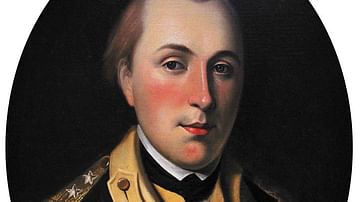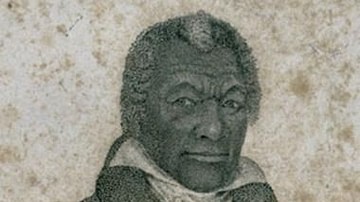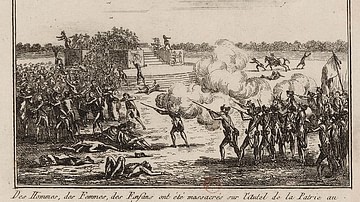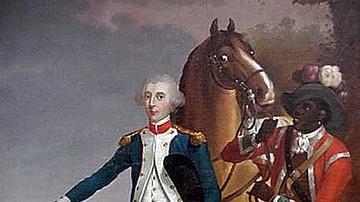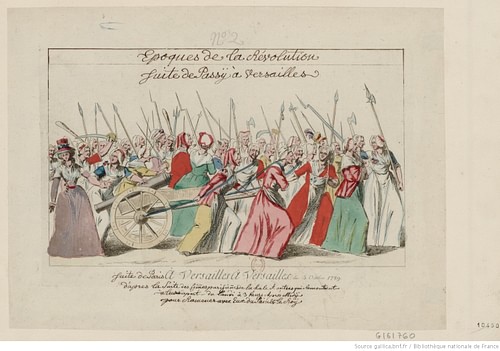
The Women's March on Versailles, also known as the October March or the October Days, was a defining moment in the early months of the French Revolution (1789-1799). On 5 October 1789, crowds of Parisian market women marched on Versailles, demanding reforms. They besieged the palace and forced King Louis XVI of France (r. 1774-1792) to return with them to Paris.
The march, which began in the marketplaces of Paris as a reaction to food scarcity and anti-revolutionary actions by the king's soldiers, stripped the king of much of his remaining independence and authority. The event was significant for delivering the killing blow to France's system of absolute monarchy later referred to as the Ancien Régime, and for ushering in France's short-lived period of constitutional monarchy.
The Death Throes of Monarchy
The waning summer days of 1789 found France's Ancien Régime on its last legs. With astonishing speed, the Third Estate (commoners) had wrested authority from King Louis XVI, forming a National Assembly from the Estates-General of 1789 with the purpose of giving France a new constitution. Since then, the Storming of the Bastille had put even more power into the hands of the revolutionaries, who had used it to first abolish feudalism and the privileges of the upper classes with the August Decrees, before recognizing man's natural rights with the Declaration of the Rights of Man and of the Citizen. As it worked on the constitution, the Assembly continued to dismantle the fundamental building blocks of the French monarchy in the royal city of Versailles. What had once been the absolutist playground of the Sun King Louis XIV of France (r. 1643-1715) was now the epicenter of the Revolution.
Although decidedly unsuited to the role of absolute monarch, Louis XVI was determined to preserve the institution all the same. To this purpose, he refused to consent to the August Decrees and the Rights of Man, which became a point of contention between himself and the Assembly. At the same time, Louis desired to retain the right of absolute veto, which would allow him to have the final say on any policy the Assembly wished to pass. This was supported by the monarchien (monarchist) faction within the Assembly, which believed France needed a strong king with centralized authority.
Opposed to this were the anti-royalist deputies. Some of these, such as the still uninfluential Maximilien Robespierre (1758-1794), believed that the king should be subservient to the will of the people and should therefore not be allowed a veto. However, many deputies began to express support for a third option, the suspensive veto, which would allow the king to delay the Assembly's actions for a maximum of 2 legislative assemblies or 4 years. Louis' chief minister, Jacques Necker (1732-1804) signaled that this would be acceptable to the king and even hinted that the king would ratify the August Decrees. Sensing a compromise, the Assembly voted 673-325 in favor of a suspensive veto on 11 September.
Those who did expect a compromise, however, were mistaken. In his official remarks on the topic, the king, while approving of the general spirit of the decrees, disapproved of their contents, such as the dismantling of feudalism. Far from ratifying the documents, it appeared to many that the king intended to use his newly approved veto power against them. This sparked outrage. Robespierre stated in one of his early speeches:
The king's reply is destructive not only of any Constitution, but even of any national right to have a Constitution. Anyone who can impose a condition on the Constitution…places his will above the rights of the nation. (Davidson, 44)
13 miles from Versailles, the city of Paris was also unsettled by the news. High bread prices led to conspiracy theories that the nobility was purposely starving the people, pushing tensions close to their boiling point. Many saw the king's reaction to the decrees and the Rights of Man as threatening to the Revolution itself. In his influential newspaper L'Ami du Peuple, journalist Jean-Paul Marat attacked the idea of the king's veto, warning his readers that, "you have nothing to expect from [aristocrats] except servitude, poverty, and desolation" (Schama, 459).
The Assembly sent their president Jean-Joseph Mounier back to the king to beg him to reconsider consenting to the documents and to increase the food supply to Paris. Upon receiving this request, Louis XVI went silent for a few days, as if considering his adopted role as citizen king. Then, on 23 September, he summoned the royal Flanders Regiment to Versailles. He had chosen absolutism and, with it, signed the death warrant of his monarchy.
The Banquet
Unlike the last time Louis XVI had summoned troops to the Paris Basin the previous July, he had not meant the Flanders Regiment to act as a threat. Instead, the king, worried about another Bastille-like riot, intended the regiment to bolster Versailles' defenses. However, the arrival of the regiment on 1 October ended up doing him more harm than good.
News of the banquet thrown by the royal bodyguards to welcome the Flanders Regiment spread throughout Paris like wildfire. Although it was commonplace enough for a garrisoned military unit to welcome its relieving force with a feast, the goings-on at Versailles were described by agitating journalists like Marat as a "gluttonous orgy," the consumption of such lavish amounts of food an insult to the starving Parisians. It was here where Queen Marie Antoinette (1755-1793) was supposed to have said, "let them eat cake," in response to the commoners' starvation, although there is no record of her ever actually saying this.
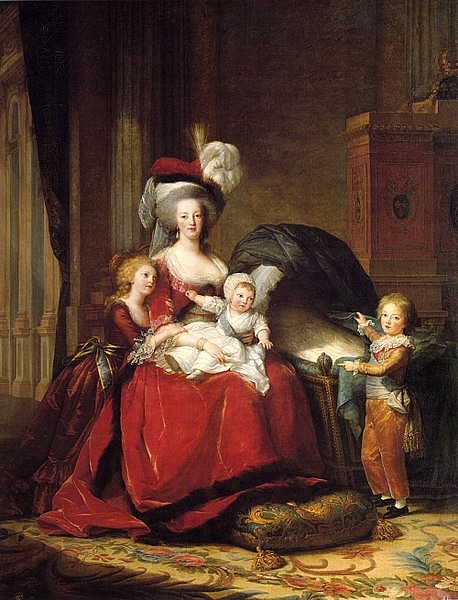
More egregious than the gluttony was the banquet's disrespect to the revolution. According to Parisian papers, the soldiers made numerous toasts to the royal family, becoming increasingly drunk as the night wore on. Eventually, royal courtiers began passing out black and white cockades (black for the queen, white for the king). It was at this point that someone produced the tricolor cockade, the symbol of the revolution, and tossed it on the ground, exclaiming, "Down with the cockade of colors!" (Schama, 460). The dinner guests then proceeded to trample the tricolor underfoot, including the queen who held the four-year-old dauphin hoisted on her shoulders.
This news was a horrifying portent to the people of Paris, who felt their hold on revolutionary gains to be tenuous at best. Already disgruntled at the high price of bread, news of the debauched royal banquet was too much to take. On the night of 4 October, a woman could be heard giving a speech in a marketplace, urging her fellow poissardes ("fishwife" or "market woman") to march on Versailles. The next day, this intention was realized.
Wrath of the Market Women
Early on the morning of 5 October, a young woman marched through the streets of eastern Paris, beating a drum. Gradually, she was joined by other poissardes from various districts, some of them carrying makeshift weapons like cudgels and knives. As the procession made its way to the Hôtel de Ville, Paris' city hall, they took control of the Church of Saint Marguerite, ringing the bells to call their fellow Parisians to action. By the time they reached the Hôtel, there were as many as 7,000 of them, chanting, "When will we have bread?"
The crowd was confronted by units of the National Guard under the command of a major Hermigny. After his troops made it clear they would not prevent the crowd from ransacking the Hôtel, Hermigny requested reinforcements and the presence of the National Guard's commander, Gilbert du Motier, marquis de Lafayette (1757-1834). In the meantime, the crowd raided the Hôtel, taking hundreds of weapons and 2 cannons.

The crowd was only dissuaded from burning down the Hôtel and lynching its officials by Stanislas Maillard, who promised to lead the crowd to the gates of Versailles itself to demand bread from the king. The mob of poissardes agreed to follow him, and the crowd began to march to Versailles amidst heavy rainfall, dragging their cannon behind them and shouting that they were coming for “le bon papa” King Louis.
Lafayette arrived at the Hôtel de Ville long after the mob had left. By then, there were serious grumbles amongst his men who wished to follow them to Versailles. Many of the National Guardsmen were formerly of the French Guards and thought it to be their duty to protect the king and to punish the royal guards who had disrespected the revolutionary cockade.
Lafayette was nervous about leading the National Guard to Versailles; for one thing, he did not wish to leave Paris undefended, and for another, he realized that to lead the National Guard to Versailles would be tantamount to leading an army to the king's doorstep. Nonetheless, his men made it clear they would march to Versailles with or without his leadership. Sending a courier ahead to alert the king and the Assembly to his coming, Lafayette hesitantly took his place at the head of the column and led 15,000 men into the pouring rain. But before the National Guardsmen had even left the outskirts of Paris, the mob of poissardes were in Versailles.
Siege of Versailles
The crowd, exhausted after their six-hour march in the rain, were greeted cordially by local magistrates, who offered them wine. They were prohibited from entering the palace grounds, which were guarded by the Flanders Regiment backed by Swiss guards, although they were admitted into the hall where the Assembly met. Hundreds of fatigued and rain-drenched poissardes collapsed on the benches in the hall, resting their muddy clubs and knives on legislative documents.
As the perceived leader of the crowd, Maillard was invited by the deputies to state the reason for the march. "The aristocrats want us to die of hunger," he replied, before claiming that a miller had been bribed 200 livres to not make bread (Schama, 463). Calls by outraged deputies to name the miller were shouted down by the women, who proclaimed that they had come to exercise their right to recall deputies, as emphasized by the philosopher Rousseau. Becoming agitated, some women began shouting anti-clerical slogans at the archbishop of Paris, while one woman slapped away a priest who had offered her his hand in greeting, snapping, "I am not made to kiss the paw of a dog" (Schama, 465). The crowd was only calmed with speeches by deputies such as Robespierre, who claimed solidarity with their plight. Once the crowd's temper had subsided the Assembly's president, Mounier, promised to take a delegation to see the king.

Louis XVI, who had been out hunting, had only just returned to the palace. He met a delegation of six women, elected by the crowd. The spokesperson of the delegation was Pierrette Chabry, a 17-year-old girl chosen for her polite manner of speech and "virtuous appearance" (Schama, 465). Yet Chabry must have been overcome with nervousness in the king's presence, as she fainted at his feet. Acting quickly, Louis ordered smelling salts to be brought and helped Chabry up. This act of paternal benevolence seemed to soften the crowd's temper. After helping Chabry, Louis promised the delegation that he would order food delivered to Paris from the royal stores, with more on their way. Although this placated some marchers, such as Maillard who returned to Paris, most others were still unsatisfied.
It was around this time, 6 pm, that Lafayette's courier arrived at the Assembly, along with news that an army was marching on Versailles. Wondering how to satisfy the remaining marchers and the National Guard, Louis XVI met with his ministers to discuss his courses of action. He decided not to flee, but instead to give in and finally ratify both the August Decrees and the Declaration of the Rights of Man. He hoped that this, which was to him a huge concession, would be enough to satisfy the people and allow him to remain in Versailles. Lafayette's men, it would seem, had other plans.
Lafayette Arrives
Just after midnight, the National Guard marched into Versailles six abreast; "their numbers were so great that even marching at the double they took an hour to pass" (Schama, 465). Many of their numbers, particularly those who had sworn to protect the king, had already made up their minds to take the royal family with them to Paris, liberating them from the clutches of their unpatriotic bodyguards. The royal guards, perhaps realizing they were in danger, withdrew to their stations within the palace grounds.
Lafayette first addressed the National Assembly, promising he had no ulterior motives and had only come to ensure the king's safety. He assured them that calm would be restored if the Flanders Regiment was sent away and if the king would make another sympathetic gesture toward the revolutionary cockade. He then took his leave of the Assembly and made his way to the royal apartments, alone. As he went, he was harangued by royal courtiers who shouted after him, "There goes another Cromwell!" (Davidson, 47). To this, Lafayette purportedly replied, "Cromwell would not have come unarmed." Perhaps to dispel the notion of himself as an aspiring dictator, Lafayette greeted the king by prostrating himself and dramatically proclaiming, "I have come to die at the feet of Your Majesty" (Schama, 466).
After the dramatics, Lafayette conferred with the king, telling him that it would be safer if he accompanied the National Guard back to Paris. Louis XVI promised the general that he would discuss this with his family and give him an answer in the morning. Fatigued, Lafayette went back to report this meeting to the Assembly before retiring to the house owned by his grandfather and collapsing on a couch.
To Paris
At 5:30 in the morning on 6 October, an armed group of people snuck onto the palace grounds and broke into the royal apartments in the Cour de Marbre. A guard would later claim that these attackers were after the queen, shouting that they wished to "tear out [her] heart…cut off her head, fricassee her liver" (Schama, 467). A surprised guard fired on the oncoming crowd before they fell on him and killed him. A second guard was able to warn the queen in time before he, too, was murdered. Running barefoot from her chambers, Marie Antoinette shouted for someone to save her children, and ran in search of them as the crowd tore through the palace, calling for her death.
Before the crowd could do the royal family any harm, they were stopped by National Guardsmen under the command of Lazare Hoche (1768-1797), later a hero of the French Revolutionary Wars. Hoche's men spirited the royal family away from danger as the crowd paraded the severed heads of the two murdered guards around on pikes.
Lafayette was woken and rushed to the aid of the royal family. The fact that he had been sleeping during the violent affair would stain his previously celebrated reputation, as Paris newspapers would later mockingly refer to him as "General Morpheus", referencing the Greek god of sleep. Arriving at the palace, Lafayette first calmed the tensions between his National Guardsmen and the royal guards before turning to the king and queen. He told them that they had to greet the crowd from atop the balcony, a proposal that terrified the queen, who had almost been murdered by them not long before. With comforting words from the general, the queen stepped onto the balcony alongside the king and their children. The crowd's reaction was lukewarm until Lafayette, ever the showman, pinned a tricolor cockade in the hat of a royal bodyguard before bowing low and kissing Marie Antoinette's hand.
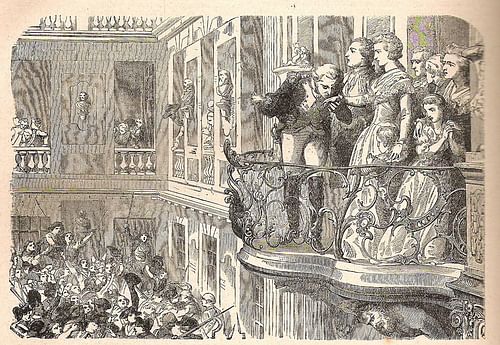
This performance paid off, as the crowd wildly applauded, chanting, "To Paris!" Louis XVI, it seemed, no longer had a choice in the matter. Resigning to his fate, he announced: "My friends, I shall go to Paris with my wife and my children…it is to the love of my good and faithful subjects that I entrust all that is most precious to me!" (Davidson, 47).
Three hours later, a massive procession set out from Versailles; Lafayette would estimate their numbers at 60,000. The National Guardsmen led the parade consisting of the royal family and courtiers, members of Necker's ministry, and deputies of the National Assembly. At the rear was a train of wagons filled with flour and bread. Women marched alongside the caravan, cheering and singing that they were bringing "the baker, the baker's wife, and the baker's lad to Paris!" This, of course, referenced the king, who was often referred to as the first baker of the kingdom.
Once in Paris, the king was awarded the key to the city and shown to the Tuileries Palace, where he and his family would henceforth reside. The Assembly took up in an abandoned riding school down the street from the Tuileries. There, they proclaimed that Louis XVI would no longer be known by the grand title of King of France and Navarre, which denoted him as an absolute monarch who ruled by divine right; from then on, he was to be simply Louis XVI, King of the French.
Although France would not officially be a constitutional monarchy until the completion of the constitution of 1791, for all intents and purposes the Ancien Régime died that day, on 6 October 1789. Symbolically, the palace of Versailles was already being boarded up, with massive iron locks placed on the gates and guards posted to discourage looters. As historian Simon Schama observes, "Versailles had already become a museum" (470).



